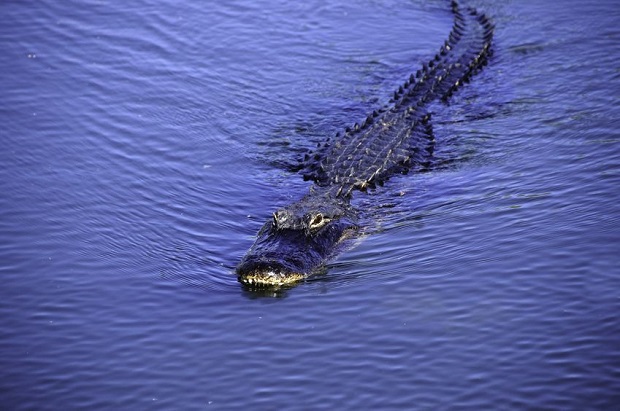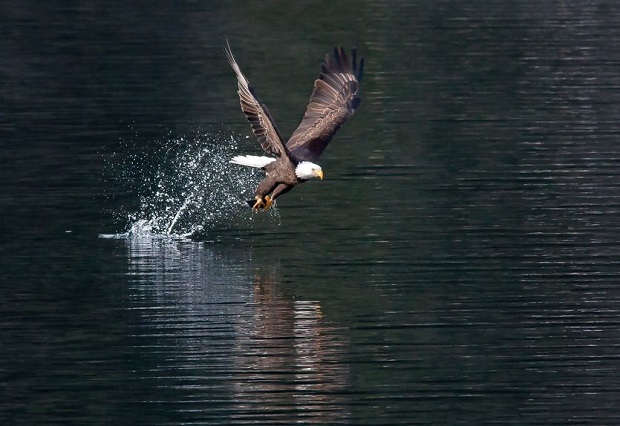
Can Alligators Swim?
Alligators can swim. An alligator will utilize various techniques to propel itself through water depending on why they are swimming and its body temperature. In some instances, it will float on top of the water, tuck its feet by its side, and use oscillatory motions of the tail to propel itself forward. In other instances, the feet will be used to paddle in conjunction with the tail. It will also swim with its head out of the water or completely submerged.
How Does an Alligator Swim?
A Duke University study conducted by researchers from the Department of Zoology concluded that an alligator that is alarmed and attempting to flee something swims differently than an alligator at rest and that its body temperature will dictate which body motions it uses to swim. For the alligator that is not alarmed, in most cases, it chooses to swim when temperatures are above 77°F. On most occasions, it will swim with its head out of the water, paddle its feet, and use its tail to glide through the water. When temperatures drop, in most cases, it chooses not to swim at all. That alligator that is alarmed and forced to swim uses only its tail. It will use its legs to paddle only when the temperature is colder. [Turner]
How Fast Do Alligators Swim?
According to the San Diego Zoo, an alligator can swim up to 20 MPH. That’s pretty fast, considering the fastest recorded speed reached by a human in swimming was 5.1 MPH, set by Tom Jager in 1990. [The Physics Handbook]
The speed at which an alligator swims, like most ectotherms, is significantly affected by temperature. Relying on external sources to regulate body temperature, the metabolism of the ectotherm slows significantly in relation to a drop in temperature. This, in turn, affects how quickly they can swim. The colder the weather, the slower they move.
Also, swimming behavior will affect how fast they swim. In the Duke University study, the researchers discovered that alligators swim much faster when completely submerged, using only the tail to propel them through the water, and swim the slowest when they are above water using their legs as paddles. [Turner]
How Long Can an Alligator Stay Underwater?
Alligator dives are generally short, between 10-20 minutes, but the alligator’s unique physiological features allow it to stay submerged for up to 2 hours if necessary. The alligator’s circulatory system adjusts when it is submerged, shutting off the blood supply to non-essential organs and tissues. Like many diving animals, its heartbeat will slow to just two to three beats per minute when it is submerged (called bradycardia), allowing it to conserve oxygen and remain submerged for extended periods. [UC San Diego]
When the colder temperatures hit, and the alligator’s metabolism slows, it can stay underwater for longer periods. According to Florida State University’s habitat checker, an alligator can stay underwater for up to 8 hours.
Alligators Can Eat While They Swim?
Alligators have unique characteristics that help them to hunt for food underwater. First, they have a nictitating membrane, a translucent membrane that acts as a second set of eyelids that can be drawn across the eye to help them see underwater. They have flaps over their nostrils and ears.
Once they have identified their prey and are ready to capture it, they have a special flap in the back of their throat called a palatal valve that closes to keep water out of the throat, lungs, and stomach while they clamp down on their prey.
Do Alligators Swim in the Ocean?
Alligators prefer fresh water such as that found in lakes, swamps, and rivers, but can be found in brackish waters and even salt water for short periods.
According to researchers from the Georgia Department of Natural Resources, it is not unusual to see alligators occasionally venture out into salt waters in search of food, but they are not equipped to venture far and are usually spotted along the shoreline. One notable exception was the alligator that the researchers discovered 20 miles out to sea while on a whale watch expedition.
Resources
Journal of Herpetology; Turner, JS
Burst Swimming of Alligators and the Effect of Temperature
1985; Volume: 19; No: 4; Pages: 450-458
http://www.esf.edu/EFB/turner/publication%20pdfs/Burst%20swimming%20of%20alligators.pdf
San Diego Zoo
American Alligators
http://kids.sandiegozoo.org/animals/reptiles/american-alligator
The Physics Handbook
Speed of the Fastest Human, Swimming
http://hypertextbook.com/facts/2000/NoahKalkstein.shtml
UC San Diego-News Release
How the alligator is able to “hold its breath” underwater for long periods of time and survive has been described in a report of research conducted at UCSD
http://www.esf.edu/EFB/turner/publication%20pdfs/Burst%20swimming%20of%20alligators.pdf
Florida State University-Habitat Checker
American Alligators
http://tracker.cci.fsu.edu/videos/nature_of_science/ALL_ANIMAL_PDFs.pdf
Discovery Kids
Are Alligators Really Dinosaurs?
http://kids.discovery.com/tell-me/curiosity-corner/animals/are-alligators-really-dinosaurs
Mother Nature Network
Alligator found 20 miles out to sea swimming with whales
http://www.mnn.com/earth-matters/animals/stories/alligator-found-20-miles-out-to-sea-swimming-with-whales





